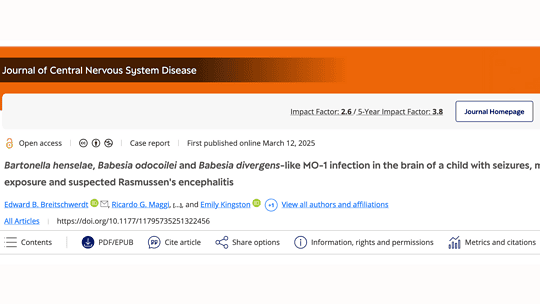
Seizures Linked to Bartonella and Babesia
Imagine a child suffering from seizures, only to discover years later that the cause might be tied to a cat scratch and an insect bite. A groundbreaking case study from North Carolina State...

Imagine a child suffering from seizures, only to discover years later that the cause might be tied to a cat scratch and an insect bite. A groundbreaking case study from North Carolina State...

Symptoms of Lyme Disease – General Overview Lyme Disease Symptom Overview Physical Symptoms Early Signs and Symptoms (3 to 30 Days After Tick Bite) Fever & Chills Headache Fatigue...

Daily tick checks help prevent tick-borne infections. Removing ticks properly is...

As evidenced by her recovery and resolution of symptoms, treating both the Lyme infection and streptococcal infection, as well as treating the underlying autoimmune etiology of her neuropsychiatric...

ASPIRE talks with Shannon L. Delaney, MD, on the latest study of Borellia miyamotoi in those with persistent symptoms and suspected tick-borne illness Gabriella, ASPIRE President, sits down with...
Borrelia miyamotoi Serology in a Clinical Population With Persistent Symptoms and Suspected Tick-Borne Illness
Delaney Shannon L., Murray Lilly A., Aasen Claire E., Bennett Clair E., Brown Ellen, Fallon Brian A. Borrelia miyamotoi Serology in a Clinical Population With Persistent Symptoms and Suspected Tick-Borne Illness. Front. Med., 27 October 2020 . DOI=10.3389/fmed.2020.567350
ABSTRACT=Eighty-two patients seeking consultation for long-term sequalae after suspected tick-borne illness were consecutively tested for Borrelia miyamotoi antibodies using a recombinant glycerophosphodiester phosphodiesterase (GlpQ) enzyme immunoassay. Twenty-one of the 82 patients (26%) tested positive on the GlpQ IgG ELISA. Nearly all of the patients (98%) had no prior B. miyamotoi testing, indicating that clinicians rarely test for this emerging tick-borne pathogen. Compared to patients who solely tested positive for Lyme disease antibodies, patients with B. miyamotoi antibodies presented with significantly more sleepiness and pain. A prospective study is needed to ascertain the relationship between the presence of B. miyamotoi antibodies and persistent symptoms.

"Education is critical to know what is out there. If we can identify cases of Lyme disease early, we can treat them right away. Then we decrease the likelihood of an infection leading to chronic...

According to the CDC, Lyme disease is the number one vector-borne illness in the United States. The CDC believes their typical numbers are underestimating the number of Lyme disease cases in any...